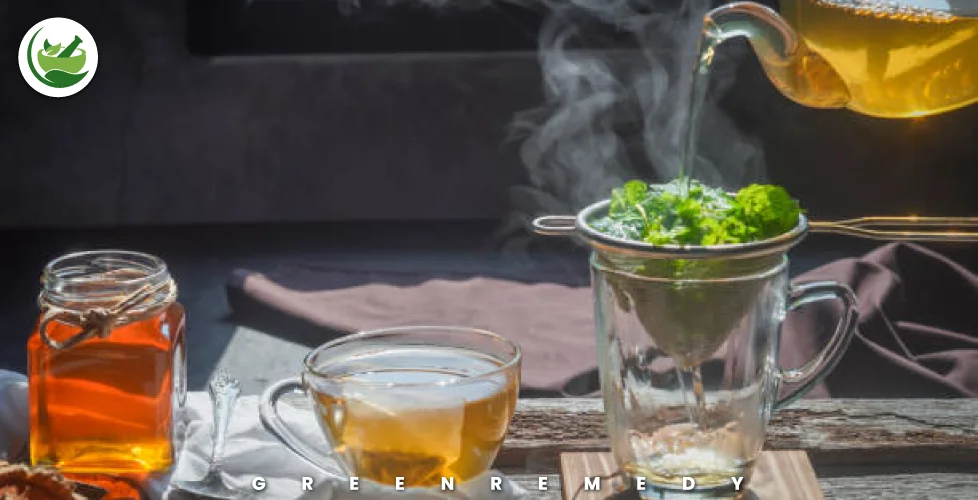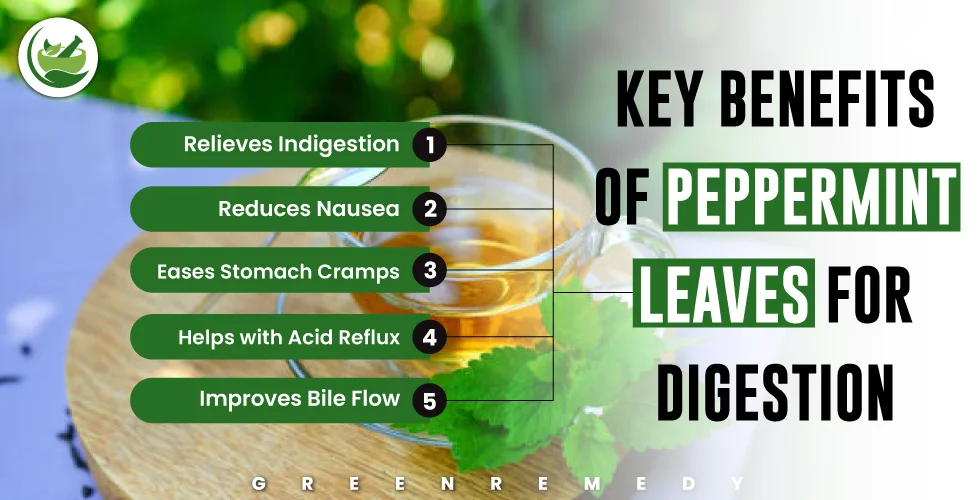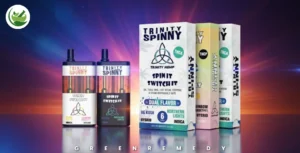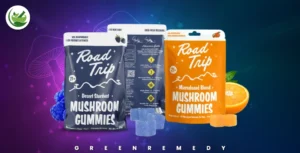
Digestive problems are among the most common health concerns in the world. From occasional bloating to persistent indigestion, these issues can affect daily life, diet, and overall comfort. While there are many remedies available, one natural solution that has stood the test of time is peppermint leaves for digestion. Known for their refreshing aroma and cooling flavor, peppermint leaves are more than just a culinary herb — they hold powerful therapeutic properties that can support a healthy digestive system.
In this detailed guide, we’ll explore the science behind peppermint leaves, their benefits for digestion, different ways to use them, and potential precautions you should keep in mind.
What Are Peppermint Leaves?

Peppermint (Mentha × piperita) is a hybrid plant that combines watermint (Mentha aquatica) and spearmint (Mentha spicata). Its leaves are dark green with a slightly purplish hue, and they contain high levels of menthol — the compound responsible for its cooling sensation and therapeutic properties.
For centuries, peppermint leaves have been used in herbal medicine to relieve gastrointestinal discomfort, ease muscle spasms, and improve overall digestion. They are commonly consumed fresh, dried, or as part of teas, tinctures, and essential oils.
Read More: Home Remedies for Toothache: Natural Relief You Can Trust
Why Peppermint Leaves Are Good for Digestion
Peppermint leaves are more than just a refreshing garnish they’re a natural digestive aid with centuries of proven use. The secret lies in their menthol-rich oils and other plant compounds that work in harmony to soothe the stomach and promote healthy digestion. Here’s why they’re so effective:
1. Relax Stomach Muscles
Peppermint leaves help relax the smooth muscles of the gastrointestinal tract. This eases spasms, reduces cramping, and allows food to move more efficiently through your system.
2. Reduce Gas and Bloating
Acting as a natural carminative, peppermint leaves help expel trapped gas from the intestines, easing bloating and discomfort after meals.
3. Stimulate Bile Flow
The natural compounds in peppermint encourage bile production, which aids in breaking down fats, making digestion smoother and less taxing on your stomach.
4. Ease Nausea and Indigestion
The cooling menthol aroma can soothe feelings of nausea, while the leaves’ gentle properties help calm indigestion naturally.
5. Support Overall Gut Health
Regular use of peppermint leaves — in teas, salads, or water infusions — supports a balanced digestive process, helping prevent recurring stomach discomfort.
Nutritional Profile of Peppermint Leaves (per 100g fresh leaves)
- Calories: 70 kcal
- Water content: 78%
- Protein: 3.8 g
- Carbohydrates: 14.8 g
- Dietary fiber: 8 g
- Fat: 0.9 g
- Vitamin A: 4248 IU (excellent for eye health and immunity)
- Vitamin C: 31.8 mg (boosts immunity and skin health)
- Vitamin B2 (Riboflavin): 0.25 mg
- Vitamin B3 (Niacin): 1.7 mg
- Vitamin B6: 0.13 mg
- Folate: 114 mcg (important for cell growth)
- Calcium: 243 mg (supports bone health)
- Iron: 5.1 mg (helps in red blood cell production)
- Magnesium: 80 mg (supports muscle and nerve function)
- Potassium: 569 mg (balances fluids and supports heart health)
- Manganese: 1.2 mg (important for metabolism and antioxidant functions)
- Copper: 0.3 mg
- Zinc: 1.1 mg
Ingredients You’ll Need for Peppermint Tea
To prepare a soothing cup of peppermint tea that supports digestion, gather:
- Fresh peppermint leaves – 8 to 10 leaves (or 1–2 teaspoons dried peppermint leaves)
- Hot water – 1 cup (about 240 ml), just below boiling
- Honey (optional) – 1 to 2 teaspoons, for natural sweetness
- Lemon slice (optional) – adds a refreshing citrus note and extra vitamin C
Read More: How to Make the Perfect Oats Porridge Recipe with Fruits
Peppermint Recipes for Digestive Bliss
1. Fresh Peppermint & Ginger Tea
Ingredients:
- 10 fresh peppermint leaves
- 1-inch fresh ginger slice
- 2 cups water
- Honey (optional)
Instructions:
- Boil water in a pot.
- Add ginger and simmer for 3 minutes.
- Add peppermint leaves and steep for 5 minutes.
- Strain, add honey if desired, and sip slowly.
2. Peppermint-Cucumber Detox Water
Ingredients:
- 1 liter water
- 1 small cucumber, sliced
- 8 fresh peppermint leaves
- 1 lemon, sliced
Instructions:
- Combine all ingredients in a jug.
- Refrigerate for 2–4 hours before drinking.
- Enjoy throughout the day for gentle detox and digestive support.
3. Minty Fruit Salad
Ingredients:
- 1 cup watermelon cubes
- 1 cup pineapple chunks
- 1 cup strawberries, halved
- 8–10 peppermint leaves, chopped
- A drizzle of honey (optional)
Instructions:
- Toss all ingredients in a large bowl.
- Chill for 30 minutes before serving.
- Enjoy as a refreshing digestive-friendly dessert.
Key Benefits of Peppermint Leaves for Digestion

Let’s explore the main digestive benefits in detail:
1. Relieves Indigestion
Indigestion can be caused by overeating, stress, or certain foods. Drinking peppermint tea or chewing fresh leaves can help your stomach settle faster by increasing the flow of digestive juices.
2. Reduces Nausea
The aroma of peppermint is known to ease feelings of nausea and queasiness. A cup of warm peppermint tea can be especially comforting after a heavy or greasy meal.
3. Eases Stomach Cramps
Menthol in peppermint leaves has antispasmodic properties that relax intestinal muscles, reducing the severity of cramps.
4. Helps with Acid Reflux (in moderation)
While peppermint can be soothing, people with severe acid reflux should be cautious — excessive consumption might relax the esophageal sphincter, allowing acid to flow back into the esophagus. Small amounts, however, may still be beneficial for mild cases.
5. Improves Bile Flow
Peppermint stimulates bile secretion from the gallbladder, which helps the body digest fats more efficiently and reduces the feeling of heaviness after fatty meals.
Peppermint Leaves vs. Peppermint Oil: Key Digestive Differences
| Factor | Peppermint Leaves | Peppermint Oil |
| Potency | Mild and gentle, suitable for daily use | Highly concentrated, stronger effect |
| Best Use | General digestion support and freshness | Targeted relief for IBS, cramps, and severe discomfort |
| Consumption Method | Fresh, tea, salads, smoothies | Capsules, diluted drops, or aromatherapy |
| Side Effect Risk | Low risk, safe for most people | Higher risk of heartburn or irritation if overused |
| Flavor Profile | Natural, subtle minty taste | Intense, cooling menthol flavor |
Read More: What Are Tukmaria Seeds? Learn About Their Health Properties
Scientific Evidence Supporting Peppermint for Digestion
Several studies have confirmed the digestive benefits of peppermint:
- A review in the Journal of Clinical Gastroenterology concluded that peppermint oil is a safe and effective treatment for IBS symptoms.
- Research published in Phytomedicine showed peppermint’s ability to reduce abdominal pain and improve bowel regularity.
- Another study found that peppermint tea can help ease bloating by reducing colonic muscle spasms.
These findings make peppermint leaves for digestion a credible choice for natural digestive support.
Uses of Peppermint Leaves
Peppermint leaves are valued not only for their refreshing taste but also for their wide range of culinary, medicinal, and household applications. Here are the most common uses:
- Digestive Support – Brewed as tea or chewed fresh to reduce bloating, gas, and stomach discomfort.
- Flavoring in Food & Drinks – Added to salads, smoothies, desserts, or cocktails for a fresh, minty taste.
- Natural Breath Freshener – Chewing leaves helps eliminate bad breath naturally.
- Aromatherapy & Stress Relief – Crushed leaves release a calming scent that can ease tension.
- Cold & Congestion Relief – Inhaled steam with peppermint leaves can help open nasal passages.
- Skin Soothing – Applied in homemade skincare masks to cool and refresh the skin.
Best Time to Take Peppermint for Digestion
The timing of peppermint consumption can make a difference in how effective it is for your digestive health. While peppermint leaves are gentle enough to enjoy any time, certain moments can maximize their benefits:
- After Meals – Drinking peppermint tea or chewing fresh leaves after eating can help prevent bloating and aid digestion.
- When Feeling Bloated or Gassy – A warm peppermint infusion can relax the digestive tract and relieve discomfort.
- Before Bed – If you’ve had a heavy dinner, sipping peppermint tea can calm your stomach and promote restful sleep.
- On-the-Go Relief – Chewing fresh leaves or sipping peppermint water can help ease sudden indigestion or nausea.
- Daily Habit – One to two servings a day (tea, water infusion, or fresh leaves) can help maintain smooth digestion over time.
Pros and Cons
Like everything else, this comes with its own set of pros and cons.
Pros:
- Relieves bloating, gas, and stomach cramps naturally.
- Helps digest fatty meals by stimulating bile flow.
- Calms nausea and indigestion with a soothing aroma.
- Gentle enough for daily use in moderate amounts.
- Versatile can be consumed fresh, in tea, or infused water.
Cons:
- May worsen heartburn or acid reflux (GERD).
- Can trigger mild allergic reactions in rare cases.
- Excessive intake might cause dry mouth or throat irritation.
- May interact with certain medications (blood pressure, heart, reflux drugs).
- Not suitable for infants, and pregnant/breastfeeding women should consult a doctor before regular use.
Why Peppermint Leaves Might Be the Digestive Hero You Need
From soothing post-meal discomfort to preventing bloating, peppermint leaves provide an all-natural, flavorful way to support digestive health. They are easy to grow, easy to prepare, and bring both taste and therapeutic benefits to your plate or cup.
If you’ve been searching for a gentle yet effective way to give your stomach a break, incorporating peppermint leaves for digestion into your daily routine could be a simple and delicious solution.
Read More: kalonji seeds benefits for hairs: Boost Growth and Shine Naturally
FAQ’s About Peppermint Leaves
Your most common questions about peppermint leaves
1. How to use peppermint leaves for digestion?
You can brew them into tea, chew fresh leaves, or add them to salads and water for a natural digestive boost.
2. Is peppermint leaf good for your gut?
Yes, it helps relax digestive muscles, reduce bloating, and improve overall gut comfort.
3. Is it good to boil mint leaves and drink it?
Absolutely — boiling releases the oils, making a soothing tea that aids digestion and refreshes you.
4. Can you eat peppermint leaves raw?
Yes, they’re safe to eat fresh and can freshen breath while supporting digestion.
5. What happens if I chew mint leaves?
Chewing releases natural oils that freshen breath, ease bloating, and calm mild stomach discomfort.
Final Thoughts
Peppermint leaves are more than just a fragrant kitchen herb — they are a time-tested natural remedy for digestive discomfort. From relieving bloating and cramps to supporting healthy bile flow, their benefits are both wide-ranging and well-documented. Whether you enjoy them as tea, chew them fresh, or infuse them in water, incorporating peppermint leaves for digestion into your daily routine is a simple, natural way to support a healthier gut.
With centuries of use and modern research backing their effectiveness, peppermint leaves remain one of the most accessible and effective herbal remedies for digestive wellness.






